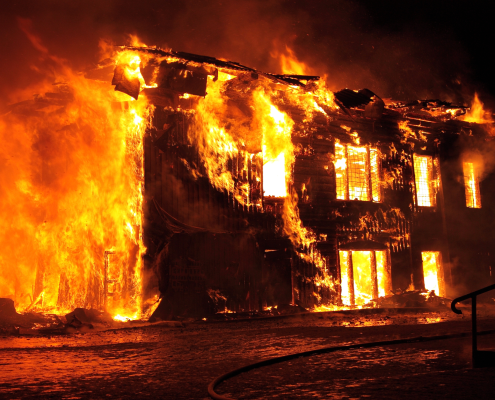Disaster Investing
By Taylor Miller, OBA Project Specialist
Tornados, hurricanes, and wildfires are realities that certain parts of the country must face. These disasters are unpredictable and therefore difficult to prepare for as a property owner or investor. In the aftermath of a natural disaster, the landscape of real estate investing becomes fraught with moral and ethical considerations. On one hand, there’s the perception that investing in disaster-impacted properties is insensitive, driving locals from their homes and capitalizing on tragedy. On the other hand, there’s the perspective of community redevelopment, addressing housing shortages, and stimulating economic recovery. It is important to explore both sides of this moral dilemma. Ethical considerations aside, there are substantial advantages to investing in recently devastated property, whether it be from hurricanes, tornadoes, or wildfires. They key is to focus on creating value for both the community and the investment.
Investing in disaster-affected real estate evokes strong emotions and polarizing opinions. Locals often view it as insensitive and opportunistic, seeing investors swooping in to profit from their misfortune. When an investor develops a site with a larger, more luxurious residence it can feel like the area is being gentrified to bring in “outsiders” effectively removing the original character of the community. For those who have lost homes and livelihoods, the sight of investors acquiring damaged properties can feel like a betrayal, which only exacerbates feelings of displacement and vulnerability.

However, there’s another perspective to consider—one centered around community redevelopment and economic revitalization. Investors who engage in post-disaster real estate investments see themselves as catalysts for positive change, not opportunists. Even some locals can find themselves adopting this point of view. Would you rather live in an area with riddled with damaged homes, looted businesses, and infrastructure that is hanging on by a thread or would you rather see those properties rehabilitated? In the wake of Hurricane Katrina there was a significant number of outside investors who cherry picked which areas to invest in leaving less desirable real estate to sit untouched. Some of those properties still sit vacant with flooding and pervasive mold issues today, almost 20 years later. Profit is the priority of any investment. However, within this niche area of real estate it is also important to consider the impact your intended project will have on the community. This type of investment should contribute to the restoration of neighborhood just as much as it should focus on an investor’s returns. By providing much-needed housing options and injecting capital into the struggling community, investors can end up being perceived in a very favorable light.
While the moral implications of investing in disaster-affected real estate are complex, there are undeniable fiscal benefits to consider. Whether it’s a hurricane, tornado, wildfire, or other natural disaster, these events can create unique investment opportunities with the potential for significant financial returns. The initial attraction is the prospect of acquiring a property at a below-market price. With many damaged businesses and homes flooding the market there is a temporary downturn in property prices. Even property that is relatively undamaged by the disaster may see a dip in price due to the overall condition of the neighborhood. When searching for the perfect property for your investment, it would be wise to seek out an experienced local inspector and contractor to provide an analysis on whether the intended renovation is financially feasible given the current structural integrity. Whether a full demolition and rebuild is intended or a renovation, it will also be important to review the permitting process with the local municipality. Some of the red tape surrounding the rebuild of disaster properties can elongate the timeline and an investor will need to ensure this aligns with the overall investment strategy. Nonetheless, purchasing a property well below market value provides an opportunity to build equity and generate large returns once the market stabilizes.
Another attractive facet of disaster investment is the potential for government assistance programs. In many cases, governments will offer incentives and assistance programs to property owners in a presidentially declared emergency zone. These incentives could include tax credits, grants, or low-interest loans for property rehabilitation. By taking advantage of these programs, investors can offset costs and maximize their returns on investment.
The social impact of investing in disaster property is the key to balancing the complex moral dilemma with the perceived returns. Investors can come out looking like rockstars if they navigate their community impact with grace. For example, there have been instances where an investor will buy several properties, some that only need renovated and others that will require a full demolition and rebuild. The renovation properties will be completed first and the investor agrees to rent these spaces at a discounted rate to the desperately needed contractors who come in from out of state to assist with the community rebuild. This shows the community that the investor is committed to the revitalization of the community, not just the profits.
Investing in real estate recently impacted by natural disasters is a complex and nuanced endeavor that requires careful consideration of both moral and financial factors. While there are valid concerns about insensitivity and opportunism, there’s also the potential for positive social impact and financial gain. By approaching disaster investing with empathy, integrity, and a commitment to community redevelopment, investors can navigate this challenging landscape while realizing the fiscal benefits of their investments. Ultimately, the decision to invest in disaster-affected real estate should be guided by a balance of ethical considerations and financial goals, with the aim of creating value for both investors and the communities they serve.
This article was published in the July / August 2024 edition of the Think Realty Magazine and can be viewed online at Think Realty.


